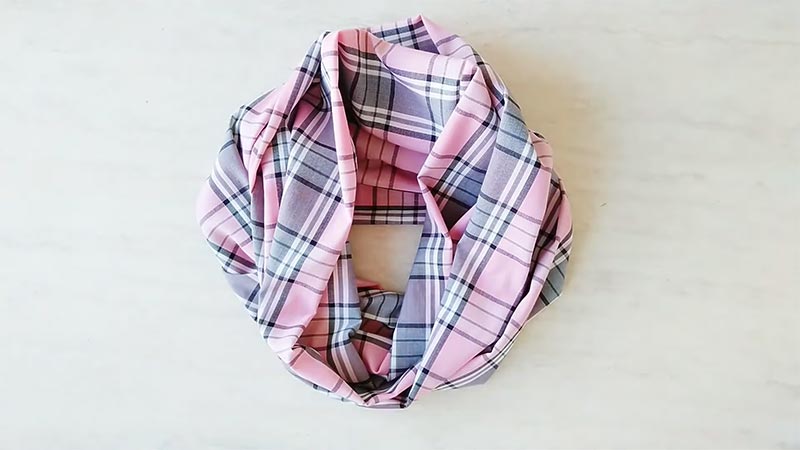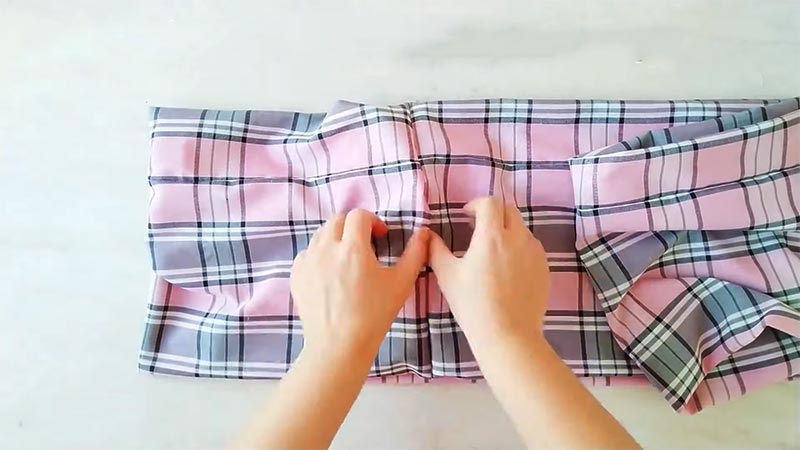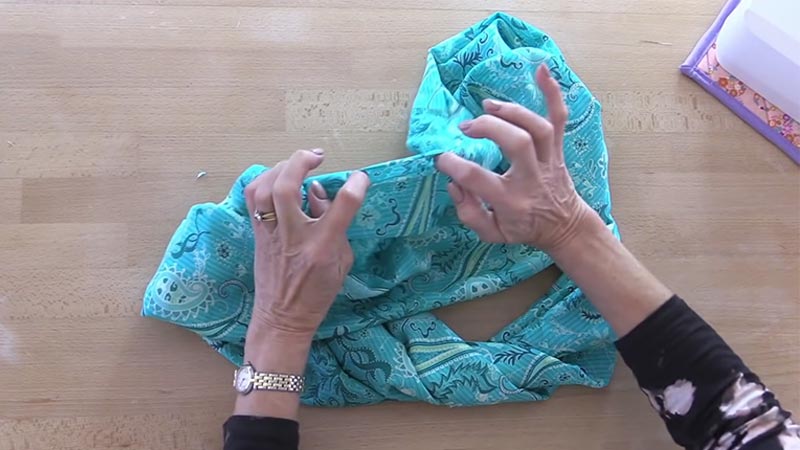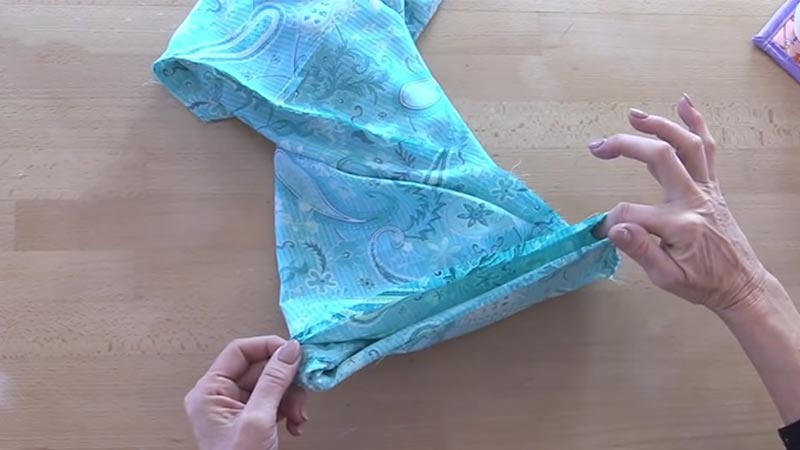Embarking on the creative journey of sewing an infinity scarf unveils a world of possibilities in fabric, style, and craftsmanship.
From selecting the perfect material to mastering essential stitching techniques, each step contributes to a unique, wearable work of art.
Whether you’re drawn to the cozy embrace of jersey knit or the opulent touch of silk, the choice of fabric sets the tone for your creation.
This guide will walk you through the intricate process, ensuring that every cut and stitch is executed precisely.
Together, we’ll transform a humble piece of fabric into a timeless accessory, ready to adorn and inspire with its endless loop of elegance.

What Is an Infinity Scarf?
An infinity scarf is a versatile and stylish accessory that forms a continuous loop, lacking loose ends. Unlike traditional scarves, it doesn’t need intricate tying or adjusting, making it effortless to wear.
Typically made from soft, lightweight fabrics like cotton, jersey, or silk, it drapes elegantly around the neck, providing warmth and adding a chic touch to any outfit.
Its seamless design allows for various styling options – it can be worn as a single loop or doubled up for a cozy, layered look.
The infinity scarf’s simplicity and adaptability make it a popular choice for both casual and formal occasions, offering a blend of comfort, fashion, and functionality in one appealing package.
How to Sew an Infinity Scarf?

An infinity scarf is a versatile and stylish accessory that adds elegance to any outfit.
It’s called “infinity” because it’s a continuous loop with no loose ends. Sewing one is a straightforward and enjoyable project, even for beginners.
Here’s a step-by-step guide on how to sew an infinity scarf:
Materials Needed:
- Fabric.
- Sewing Machine.
- Thread.
- Pins or Clips.
- Scissors.
- Measuring Tape or Ruler
- Iron and Ironing Board.
Steps:
Preparation
Wash and iron your fabric to remove any wrinkles or sizing. Determine the dimensions of your scarf.
A common size is about 60 inches in circumference and 14-16 inches in width, but you can adjust these measurements to suit your preference. Cut your fabric accordingly. If you’re using a printed fabric, ensure the pattern is facing correctly.
Fold and Pin
- Fold Lengthwise: With the right sides of the fabric together (if applicable), fold the fabric in half lengthwise. This means that the “ugly” side of the fabric should be on the outside.
- Pin or Clip: Use pins or fabric clips to secure the layers together along the long edge. This will ensure that the fabric stays in place while you’re sewing.
Sew the Long Edge
- Select Stitch and Seam Allowance: Choose a straight stitch if you’re using a sewing machine. Begin sewing about 1/4 inch from the edge of the fabric to leave a seam allowance. If you’re hand-sewing, use a backstitch to secure the seam.
- Backstitching: Always backstitch at the beginning and end of your seam. This means sewing a few stitches in reverse to lock the seam in place and prevent it from unraveling.
Turn Right Side Out
After sewing, reach through the loop you’ve created and start pulling the fabric through. This will effectively turn the scarf right side out.
Press
Use an iron on a low to medium heat setting. Press the scarf flat, paying special attention to the seam. The goal is to ensure the seam is centered and flat for a clean finish.
Close the Loop
- Fold Again: Fold the scarf in half again, but this time match up the short edges. This will create a loop.
- Pin or Clip: Secure the layers along the short edge using pins or fabric clips.
- Sewing the Short Edge: Sew along the short edge using a 1/4 inch seam allowance, backstitching at the beginning and end.
Finishing
- Trimming Excess Fabric: Trim any excess fabric near the seam after sewing. Be careful not to cut too close to the seam itself.
- Final Press: Turn the scarf right side out once more and give it a final press with the iron. This ensures that all the seams lie flat and the scarf looks clean and professional.
8 Types of Fabric Is Good for Infinity Scarf

The choice of fabric for an infinity scarf greatly influences its comfort, warmth, and overall appearance.
Here are some fabrics that are popular and suitable for making infinity scarves:
1. Jersey Knit
Jersey knit fabric is a soft, stretchy material that’s comfortable against the skin. It’s made from a combination of natural and synthetic fibers, resulting in a fabric that drapes beautifully.
Due to its stretch, it’s forgiving for beginners and easy to work with. Jersey knit scarves are ideal for everyday wear, providing a casual yet stylish look.
2. Cotton
Cotton is a natural, breathable fabric known for its softness and comfort. It’s relatively easy to work with and comes in various weights and finishes.
Lightweight cotton scarves are perfect for milder seasons. They offer a versatile accessory option suitable for both casual and semi-formal occasions.
3. Rayon
Rayon is a semi-synthetic fabric that mimics the softness and silkiness of natural fibers. It’s known for its beautiful drape and elegant feel.
Rayon blends are often used as more affordable alternatives to silk. They create scarves that exude refinement and add a touch of sophistication to any ensemble.
4. Flannel
Flannel is a soft, brushed fabric known for its warmth and coziness. Typically made from cotton, it offers a comforting feel against the skin.
Lightweight flannel scarves are excellent choices for colder weather. They provide a layer of warmth and comfort, making them popular accessories for the winter season.
5. Silk
Silk is a luxurious natural fiber known for its smooth texture and vibrant shine. It’s one of the more high-end fabric choices, offering an opulent feel against the skin.
Silk scarves are perfect for adding an elegant touch to outfits. They drape gracefully and exude a sense of sophistication.
6. Fleece
Fleece is a synthetic fabric known for its warmth, softness, and plush texture. It provides a cozy and comforting feel, making it an excellent choice for winter accessories. Fleece scarves offer exceptional insulation, keeping you warm even on the coldest days.
7. Chiffon
Chiffon is a lightweight, sheer fabric with a delicate, airy texture. It’s typically made from silk, polyester, or other synthetic fibers.
Chiffon scarves add an ethereal touch to your outfit. They drape gracefully and provide a sense of lightness and elegance.
8. Wool
Wool is a natural fiber known for its warmth, softness, and excellent insulation properties.
It’s available in various types, including merino and blends. Wool scarves, especially those made from merino wool, are ideal for keeping warm in cold weather.
Sewing Tips for an Infinity Scarf

Sewing an infinity scarf can be a fun and rewarding project. Here are some sewing tips to help you create a beautiful and well-made infinity scarf:
Choosing the Right Fabric
Selecting the fabric is a crucial step in making an infinity scarf. Consider the occasion and the level of comfort you desire. Jersey knit offers a casual, relaxed look and is perfect for everyday wear.
On the other hand, silk exudes elegance and is ideal for more formal occasions. Pay attention to the feel of the fabric against your skin and how it drapes, as these factors will contribute to the overall comfort and style of the scarf.
Pre-wash and Iron
Pre-washing your fabric is essential for several reasons. It removes any sizing or chemicals that might affect the texture or color of the fabric.
It also helps prevent any potential shrinkage after the scarf is completed. After pre-washing, iron the fabric to remove any wrinkles or creases.
This step ensures that you’re working with a smooth, even surface, making the sewing process much easier.
Cutting the Fabric
Using the right tools for cutting is crucial for precision. Sharp fabric scissors or a rotary cutter on a self-healing mat ensure clean and accurate cuts.
Cut straight lines, making the sewing process smoother and the final product more polished.
Pin or Clip Layers
Securing the layers of fabric is essential to prevent any shifting while sewing. Use straight pins or fabric clips to hold the layers together. This ensures that the fabric stays aligned, resulting in even seams and a well-finished scarf.
Stitch Type and Seam Allowance
Choosing the appropriate stitch type and seam allowance depends on your fabric. A straight stitch is suitable for most fabrics, but adjust the stitch length based on the fabric’s thickness.
A 1/4-inch seam allowance is commonly used for infinity scarves, but this can be adjusted if you have specific preferences or requirements for your project.
Backstitching
Always start and end your seams with a few back stitches. This simple technique locks the stitches in place, preventing them from coming undone over time. It’s a crucial step for ensuring the durability of your scarf.
Matching Fabric Patterns
When you’re using a patterned fabric, take the time to match the patterns along the seam. This attention to detail creates a seamless look, where the patterns flow seamlessly from one section to the next.
Pressing Seams
After sewing each seam, use an iron to press it flat. This step sets the stitches and helps create crisp, professional-looking seams. It also ensures that the fabric lays flat, enhancing the overall appearance of the scarf.
Joining the Ends
When sewing the short ends of the scarf together, accuracy is key. Take care to align the fabric pieces precisely. Pinning or clipping them together before sewing ensures that the seam is neat and well-finished.
Trimming Excess Fabric
After stitching the ends together, trim any excess fabric. This step reduces bulkiness at the seam and creates a cleaner, more polished finish for your scarf.
Finishing Seams
Consider finishing the seams for added durability and a professional look. Options include using a serger, which trims and seals the edges, or using a zigzag stitch along the raw edges to prevent fraying. Seam-binding tape is another option for a clean and polished finish.
Trying a Walking Foot
For slippery or stretchy fabrics, like silk or jersey, a walking foot attachment for your sewing machine can be incredibly helpful. It feeds the fabric evenly, preventing any stretching or distortion during the sewing process.
Experimenting with Stitch Patterns
Depending on your fabric and personal style, consider trying different stitch patterns. A zigzag or decorative stitch can add a unique and personalized touch to your scarf, making it stand out.
Topstitching
Adding topstitching along the seams can provide a decorative element to your scarf. It not only adds visual interest but also helps the seams lay flat, enhancing the overall appearance and durability of the scarf.
Matching Thread
Choose a thread color that matches the fabric. This ensures that your seams blend seamlessly and look clean and professional.
Testing on Scrap Fabric
Before sewing the actual scarf, it’s a good idea to practice on a scrap piece of fabric. This allows you to familiarize yourself with your machine settings and understand how the fabric behaves.
Measuring for Size
Accurate measurements are crucial for achieving the desired size and look for your scarf. Take your time to measure the fabric carefully, adjusting the dimensions to achieve the desired style.
Hand-sewing If Needed
If you prefer a hand-sewn look or don’t have access to a sewing machine, consider sewing the scarf by hand. Techniques like the slip stitch or backstitch can create strong and neat seams.
Enjoying the Process
Remember that sewing can be a therapeutic and enjoyable creative process. Take your time, savor each step, and don’t rush the project. The more you enjoy the process, the more likely you will end up with a beautifully crafted infinity scarf.
FAQs
What’s the Recommended Fabric for an Infinity Scarf?
Opt for soft, drapey fabrics like jersey knit, silk, or lightweight cotton for a comfortable and stylish result.
Do I Need a Sewing Machine to Make an Infinity Scarf?
While a sewing machine can speed up the process, you can also hand-sew an infinity scarf using basic stitching techniques like the slip stitch or backstitch.
What’s the Ideal Size for an Infinity Scarf?
Standard dimensions are around 60 inches in circumference and 14-16 inches in width. However, feel free to adjust based on personal preference.
How Can I Ensure the Pattern Aligns in a Printed Fabric?
Match up the patterns along the seam before sewing. This ensures a seamless look where the patterns flow from one section to the next.
Is Pre-washing the Fabric Necessary?
Yes, pre-washing removes sizing and potential shrinkage. It also allows the fabric to relax, ensuring a consistent look after your scarf is completed.
Wrap Up
In crafting an infinity scarf, the journey from fabric selection to final stitches is a testament to creativity and skill.
Choosing the right fabric sets the tone for casual comfort or elegant flair. Precise cutting and careful pinning ensure seamless construction, while mastering stitching techniques guarantees durability.
Attention to detail, like pattern alignment and topstitching, transforms a mere fabric into a stylish accessory. Whether utilizing a sewing machine or hand-stitching, the process is an artistry that rewards patience and precision.
Through these steps, an infinity scarf emerges, a testament to the beauty that emerges when creativity meets craftsmanship, ready to adorn and warm with every graceful loop.
Leave a Reply